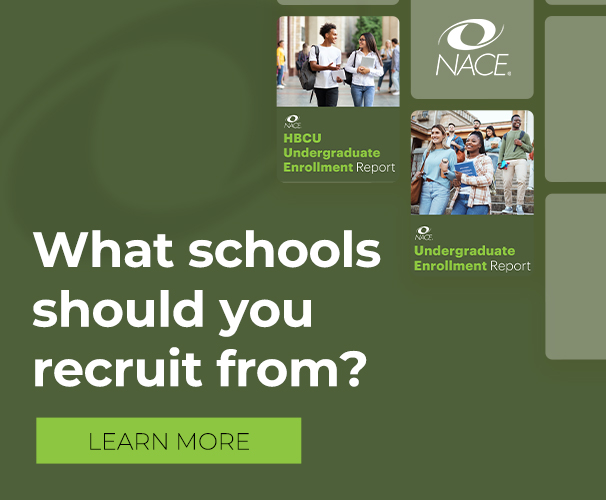How can we support students who have been marginalized or are the victims of racism? And how do we do that while working with recruiters in law enforcement in the coming recruiting cycle? How do we balance these two things: supporting students who may feel unsafe around law enforcement while also supporting employers in law enforcement?
Several members of the NACE Community responded with things career services professionals can do to get started in addressing these issues and links to resources:
It Takes Leadership
Let's be honest. Career services is a reflecting of the institution and most institutions do not do a good job in this area of diversity, equity, and inclusion (DEI). So, here are my suggestions....some of this is out of frustration and some you can do! This takes bold leadership and I am speaking toward black people not DIVERSITY—that word gets watered down. I am talking black....I am not going to say diversity.
- Work to fund black student organizations on campus. Pay them to support, attend, and participate in fairs and workshops. If you have to ask yourself why? Reach out to me—it's too long to explain.
- Hold your employers accountable: Stop sending black kids to employers with "FIT" comments, and no other folks like them there at the organization, and no leadership in the C-Suite that reflects them. These corporate environments set our black students up for failure because folks can put out statements all day.....ACTIONS is what needed, and employers bring in the talent but can't retain them and they wonder why (I can teach you), but they are not ready.
- “We couldn’t find/hire any qualified minority candidates.” Rates of college educated black folks are higher than they’ve ever been. Yet your search committees and hiring managers can’t seem to find and hire them?
- Use the NFL Rooney rule for career services and employers every time you interview for a candidate for your office, you need to have a black finalist candidate period. It’s called systematic change and righting wrongs.
- Develop a true language-oriented, metric-based strategy and strategic plan for black students, or a plan that leads with equity first. Notice I said equity and inclusion not diversity.
- Start pushing for inclusive language on resumes and names that are mentioned to employers.....I should not have to use white sounding name to get a job!
- Work with your diversity office and parent’s association on more outreach.
- Start putting some black art, literature, speakers, suppliers, and business owners in your space. That means buy coffee or staff lunch from a black business, make everyone read a book by a black author for staff development, put up black art in your offices, more black alumni to speak to ALL students and not just one for the panel.
- I have more.....I am just tired.
Tierney Bates, assistant vice chancellor and interim executive director, university career services, The University of North Carolina at Chapel Hill
Consult the Checklist
I created a checklist and started creating a running list of ideas on how to bring more inclusion into career centers for a NACE conference presentation several years back, with best practices in diversity, equity, and inclusion. This tool helps you identify what you currently have in place and highlights areas you might need to do more work on. These are tangible actionable items career centers can do now.Shelagh Saenz, director of career development, University of Michigan – School of Public Health
Examine Your Organization
Here are some thoughts:
- Do an audit of your guidance and educational materials. How do you guide students who ask you how they can prevent being discriminated against by employers based on their name or physical appearance? Do your images used in workshops and events show inclusivity of students from marginalized backgrounds? Do the names of the resumes used in your educational materials reflect diversity?
- Look at your employer policy. Do you clearly state that employers must follow applicable EEOC and other non-discrimination rules? What is your policy when you hear a complaint from a student who has been discriminated against?
- Look at yourself. Have your staff taken steps to assess any internalized racism you may have? Have you read books that will help you raise self awareness about your beliefs and behaviors when it comes to how students are treated? Here is a good starting place: A list of anti-racism resources for white people.
- Do you have people of color or from marginalized backgrounds in your own staff, especially in leadership roles? Do you partner with any affinity groups for students of color when you design programming and events?
Heather Krasna, assistant dean/director, Columbia University - Mailman School of Public Health
Refer to These Resources
We have developed an extensive list of resources—Resources for a Diverse Community you might find helpful. Students of color and other marginalized groups are largely absent from mainstream resources, so we have found that making this available is not only informative but also sends the message that we are "seeing" these students and proactively seeking related resources.
Tobi Hay, director of the career development center, SUNY Plattsburgh
Offer Safe Spaces
As a person-of-color in career services, I have found that I have unique and tailored conversations with students that they probably would not feel comfortable asking other counselors/coaches.
For example: asking about whether they should wear their natural hair for an interview, wondering if they should use their "white-sounding" middle name on their resume instead of their birth name, deciding if they should include that they are a part of the black student club on their resume in fear of discrimination. It is important to have staff of color in your office so that your students of color can bring their full selves and experiences to the room.
Additionally, mentorship should be a huge part of helping our black students feel seen and heard. Providing opportunities for students to engage in safe dialogue with other professionals that have gone through similar experiences are extremely validating. Ensuring that they are reflecting on panel, coffee chats and any opportunities to engage with alumni are super helpful.
Additionally, I think during this time, checking in with your own team/leadership. Asking yourself: Has our office put out a statement to show our solidarity and support of our black students? Have we reached out to the black students/clubs/organizations to show our support?
For employers, I think it is important to advocate on behalf of the students. Educating them on the value of diversity in the workplace and asking them about their organization's core values.
Overall, it is important that career services take several steps to ensure students have multiple safe spaces to explore both their personal and professional identities.
Fatim Lelenta, assistant director, Graduate Student Career Development, New York University, Wasserman Center






